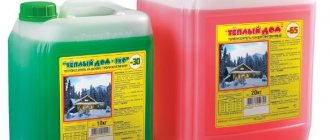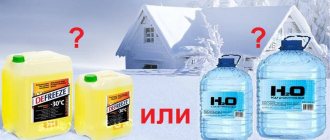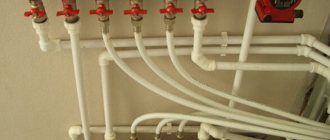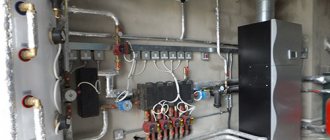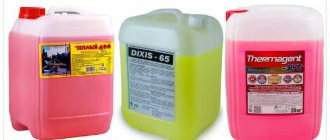Component Specifications
Pure glycerin is a transparent liquid and belongs to trihydric alcohols. Mixes well with water or alcohols in any proportions. Under industrial conditions, the substance is obtained synthetically from propylene. It occurs naturally in the base of oils or fats. Has the following technical characteristics:
- Colorless;
- Odorless;
- Transparent;
- Melts at 18 °C, boils at 290 °C;
- The density of the substance is 1.27 g/cm³;
- The refractive index is 1.473.
Comparison of glycerin coolants with analogues
Glycerin-based coolants have virtually no restrictions on their use. They are used in closed and open heating systems operating in a wide range of temperatures, including in facilities with increased requirements for the environmental safety of devices.
Gitserin does not have the disadvantages that other coolants have. For example, the popular and inexpensive ethylene glycol is a very toxic substance that can affect the human body by entering it through the respiratory system or skin. In addition, it has a low freezing point. All this makes it unsuitable for use in open circuits, in systems operating in harsh climates, in child care institutions, in food production, and so on.
Coolants based on propylene glycol, despite many advantages, still have several significant disadvantages:
- high price;
- incompatibility with galvanized pipeline parts (causes the formation and deposition of sediment);
- limited temperature range of use due to freezing at -35 degrees Celsius.
Using glycerin as a coolant
H2_2
To obtain a glycerin-based coolant, the pure substance is mixed with various impurities that allow it to remain liquid when used in cold conditions. The resulting composition is chemically inert, and no chemical processes occur inside that can have a detrimental effect on the elements of the entire system.
The ability to maintain a liquid state at sub-zero temperatures and absolute safety for humans allows the coolant to be used for heating systems in residential buildings, including floor heating.
The operation of this heating system is based on one principle: there is a heater, heating elements and coolant. In this case, the main characteristics of the coolant will affect the overall heating efficiency.
Important! It is necessary to decide which coolant will be used in the underfloor heating system at the design stage. This will affect the choice of equipment, pipe diameter and length of circuits.
Advantages of glycerin coolant
Compared to propylene glycol or ethylene glycol compounds, this antifreeze has the following advantages:
- Can be used in a wide temperature range from -30 to +105 °C. Even when the substance is completely frozen, it does not expand and does not cause damage to the pipes. After thawing, all its original properties are restored.
- The coolant is sold ready-made and does not require additional dilution with water. Glycol formulations must be diluted;
- Antifreeze does not cause corrosion or other damage to heated floor elements, including galvanized pipes and rubber gaskets;
- The substance is absolutely safe for human health and the environment, which is very important in case of leaks or damage to the system as a whole;
- At a relatively high price, the composition has a long service life of up to 8 years. Another type of antifreeze has been used for about 5 years;
- The coolant can be poured into the pipes after any other type of antifreeze; no flushing is required;
- Antifreeze is produced only from high-quality raw materials, which are also used in the food and cosmetic industries;
- Belongs to the class of non-flammable substances.
Advice! When filling the pipes, you can add a little fluorescent dye to the antifreeze. In the event of a leak in the system, the dye will help quickly locate the leak.
Disadvantages of glycerin composition
Glycerin-based coolant has its disadvantages, which must be taken into account when designing a heated floor:
- When freezing, the density and viscosity of the glycerin composition increases, which leads to a decrease in its heat capacity. In the heating system project, you will have to use pipes of a larger diameter than when using ordinary water;
- The high viscosity of the composition will require the installation of a more powerful circulation pump in the heating system;
- Glycerin-based antifreeze requires the use of reliable and expensive gaskets and seals during heating installation. Teflon or paronite gaskets are recommended;
- Antifreeze has a tendency to foam, which can cause the heated floor to become airy. Special additives help to partially reduce foaming;
- A glycerin-based composition has a density and mass greater than a glycol-based one. The use of a glycerin composition in a heated floor system will increase the load on the floors and foundation of the building.
Technical characteristics of glycerin-based coolants
Glycerin based coolant
When deciding to purchase a coolant produced using glycerin, you should definitely analyze the main parameters of the latter so as not to experience unnecessary difficulties in the future with the operation and maintenance of CO:
- The temperature range in which the specified coolant will operate normally, without significant losses in its consumer parameters.
- The heat capacity of glycerin, i.e. the required amount of coolant that needs to be pumped per unit of time in order to transfer the required amount of heat.
- Viscosity coefficient, which affects the circulation rate of the coolant, the value of the heat transfer coefficient, etc. and its change depending on the temperature of the coolant.
- Corrosive activity, which imposes a number of restrictions on the use of coolant with glycerin additives without adding the required corrosion inhibitors, as well as on the choice of coolant circuit material.
- Issues of safety of using such coolants for the environment and humans.
- Lubricity, which determines the restrictions imposed by the use of the specified coolant on the design of CO elements.
- An indicator of inertness to foaming, which directly affects the efficiency of the transfer pump.
The ideal choice is a glycerin-based coolant, the chemical composition of which takes into account the possible results of its interaction with all substances currently used in the designs of heating boilers and CO heating lines of private houses (steel, cast iron, copper, aluminum). Because otherwise reactions may occur leading to electrochemical corrosion.
Glycerin in the heating system must have additives that prevent oxidation and foaming.
Inhibitors that increase the fragility of polymers (seals, pipes) must be strictly excluded.
Benefits of using glycerin for heating
- A coolant containing glycerin has a significantly lower crystallization temperature (the freezing point of glycerin is minus 30 degrees).
- Glycerin is explosion- and fire-safe because it doesn't ignite at all.
- Such coolants are harmless to health.
- The level of heat transfer significantly exceeds similar indicators of other coolants.
- CO with the specified coolant is capable of operating at temperatures from -30 degrees to +105 degrees.
Glycerin for heating does not have a hazard class assigned to it and, according to international standards, is considered a food additive with code E 422.
Disadvantages of glycerin-based coolants
- The high viscosity of the coolant requires pumps of increased power and performance, or dilution with various alcohols, including methyl alcohol.
- Strong foaming, leading to the appearance of air in the heating lines, which impairs the heat transfer of the network.
- The presence of glycerin sharply increases the quality requirements for seals and gaskets used in CO, which are made of plastic and non-polar rubber.
- The likelihood of corrosion in the metal parts of the CO increases significantly.
- High-temperature heating of glycerin leads to the formation of acrolein, which is a highly toxic substance with an extremely unpleasant odor and tear-producing effect.
Having given preference to a non-freezing liquid, you need to understand that the system does not require car antifreeze, ethyl alcohol or transformer oil, but a special glycerin-based antifreeze, which is created specifically for use in heating systems.
We cannot discount the requirements regarding fire safety, as well as the requirements for the chemical composition of antifreeze from the point of view of the safety of its components for human health.
Selection and use of glycerin coolant
Glycerin coolant is presented on the market by manufacturers Gulfstream, Eco-30, Teplokom, PRIMOCLIMA, Olga. The compositions of different brands differ in color and type of impurities.
For the convenience of consumers, antifreezes are sold packaged in 10 or 20 kg cans, as well as in 50 kg barrels. To fill a heating system with a volume of 100 liters, about 115 kg of coolant will be required.
When pumping the composition, specialized equipment is required. It is recommended to involve specialists to fill the heating complex. First of all, all heating equipment is cleaned.
To fill the complex with antifreeze you will need a pump, a hose, a pressure gauge, a large container for coolant and equipment for subsequent pressure testing. After filling the heating complex, it is pressure tested.
Glycerin and heating
Share
Link copied to clipboard
Let's look at the facts:
- For the production of coolants, only glycerin of the highest purity, almost food grade, is used. Glycerin of this quality is produced mainly in Europe, its price is only slightly lower than the price of ethylene glycol. To achieve the same freezing point, glycerin must be used 10-12% more than ethylene glycol and the difference in cost is 5-7%. At the moment, there is no longer enough glycerin in Europe; exports mainly come from Argentina. When using glycerin of lower quality, sedimentation is inevitable, since in the process of manufacturing coolant from unrefined glycerin, a brown liquid with an unpleasant odor is obtained; it is impossible to use such a product.
- The thermophysical characteristics of ethylene glycol solutions are an order of magnitude better than the similar characteristics of propylene glycol and glycerin solutions. The only drawback of ethylene glycol is that it is extremely toxic 50 g. lethal dose, i.e. If a solution of ethylene glycol gets on the floors of a living room, it is no longer enough to wipe it with a damp cloth; it is advisable to remove this section of the floor entirely. Ethylene glycol vapor is only an order of magnitude less toxic than mercury vapor. Therefore, all major manufacturers of coolants recommend using ethylene glycol-based coolants exclusively in technical rooms.
- 10-15 years ago, only propylene glycol could be an alternative to poisonous ethylene glycol; glycerin production volumes were not enough for this type of product. At the moment, the production of glycerin has reached the required volumes; accordingly, glycerin-based coolants have appeared among the environmentally friendly coolants.
- A comparative analysis of the thermophysical characteristics of propylene glycol and glycerol solutions gives similar results. The most important indicator is viscosity. According to an independent examination, the kinematic viscosity of a glycerin solution at minus 20 degrees is 14% lower than the viscosity of a propylene glycol solution, therefore, glycerin-based coolants have an overwhelming advantage in operation. As the temperature increases, the difference in kinematic viscosity practically disappears, i.e. When the system reaches operating mode, solutions of propylene glycol and glycerin behave identically.
- Regarding foaming. There are two characteristics of this process: the total volume of foam and the disappearance time. Solutions of glycerin and propylene glycol, due to their higher viscosity, produce foam volumes that are an order of magnitude lower than the volumes of foam produced by ethylene glycol solutions under similar conditions; accordingly, the time for the disappearance of foam in solutions of propylene glycol and glycerin is an order of magnitude longer than in ethylene glycol solutions. The problem of foaming is easily solved by using special defoamers. The AVT-ECO-30 coolant uses organosilicon PMS-200A.
- Regarding the issue of corrosion. To produce coolant AVT-ECO-30, an original complex of anti-corrosion additives was developed, adapted to the glycerin base and composition of metals used in heating systems. For the main metals used in the heating system (copper, brass, steel, aluminum), it was possible to achieve indicators that exceed GOST 28084-89 by an order of magnitude. Our company does not use methanol in the production of coolants.
- On the issue of acrolein formation. The process of separating water molecules, i.e. the formation of acrolein begins in the vapor of pure glycerin at a temperature exceeding 150 degrees Celsius and a pressure exceeding 7 atmospheres. When an aqueous solution of glycerin (coolant) is heated according to La Chatelier's law, dehydration does not occur. In a heating system, conditions for the formation of acrolein cannot arise, even theoretically.
Based on the foregoing, we can conclude: at the moment, in the class of environmentally friendly coolants, there is no alternative to glycerin compositions, since having similar performance characteristics to propylene glycol compositions, they are much cheaper. In conclusion, I would like to say that when choosing the type of coolant, you should first of all pay attention to the history of more than 15 years in the antifreeze market, of which more than 10 years have been the official supplier of antifreeze and antifreeze to the gas station network of Gazpromneft CJSC.
Rules for operating complexes with glycerin antifreeze
Glycerin coolants have a long service life if the basic rules are observed:
- Antifreeze must not be allowed to overheat. Otherwise, the anti-corrosion impurities at the heart of its composition may disintegrate and form deposits on the surface of the heating elements, which impairs the operation of the heating system as a whole;
- The low coefficient of surface tension of the composition helps reduce swelling of the seals. To reduce the likelihood of leaks, it is necessary to make additional tightening at the junctions of different elements;
- At low temperatures, the coolant in the pipes will have a viscous state with individual crystals of the substance. When starting the equipment, you must first turn on the minimum speed of the heater and increase it gradually. Such a start will avoid premature breakdown of the boiler. The heated composition will have all its original properties.
Based on glycerin (coolant for heating systems)
When it comes to heating systems, antifreeze, which acts as a coolant, is a key component. The quality of antifreeze directly affects the service life of other elements, from boilers to radiators. takes into account the peculiarities of the functioning of engineering systems and offers the consumer a high-quality product created specifically for autonomous heating networks.
Advantages of branded antifreeze "Teplokom" for heating systems
Antifreeze for use in heating systems, presented, is an excellent choice that allows you to solve problems that you have previously encountered. Antifreeze for autonomous heating systems is characterized by a number of advantages that set it apart from other options:
- Antifreeze for a modern heating system protects the network and individual elements from corrosion with the help of coolant additives used.
- Antifreeze for a modern heating system guarantees safe use without damaging seals and gaskets, zinc-coated pipes, aluminum radiators, and so on.
- Antifreeze for a modern heating system allows the network to operate in a wide temperature range - from -30 to +105 degrees - due to the properties of the coolant.
- Food-grade glycerin is used to make antifreeze poured into an autonomous heating system. Glycerin in the coolant base is absolutely inert and does not harm the elements of the system. Glycerin in the coolant in systems and heating using glycerin coolant are safe for people and animals. This coolant does not belong to the category of flammable and toxic.
- Antifreeze for a modern heating system can be used without first mixing the coolant and water. Filling the system and using coolant is very simple.
- It is possible to use antifreeze as a coolant for a long period of time without replacement. Antifreeze for autonomous heating systems has a service life of 8 years, provided the recommended temperature conditions are observed. Working with coolant in heating systems does not require regular flushing after other coolants have been poured into the system. The coolant is suitable for systems with zinc-coated pipes, aluminum radiators, etc., while other ethylene glycol-based coolants destroy these elements.
- Antifreeze for heating systems and existing air conditioning systems, presented, is unique. Even if the coolant inside the system has completely frozen due to a drop in temperature below a critical level, the equipment does not defrost, and the coolant cannot damage the system. The coolant inside the system can thaw, after which it completely restores its original properties.
Antifreeze "Teplokom" - high-quality coolant for comfortable use
The high quality of the coolant in the form of antifreeze for use in the heating system determines that this particular type of coolant is recommended for use in trench convectors with heat exchangers made of copper and aluminum. Even manufacturers of electric heated towel rails prefer a proprietary type of coolant for pouring into the devices.
With coolant, the system and heating are not in danger. You don't have to get used to antifreeze in heating systems. Coolants in the form of antifreeze when used in a heating system do not cause the slightest problems or difficulties. Using antifreeze for heating is even easier than you might imagine.
Recommendations for purchasing and using Teplokom coolant
We recommend carefully calculating the coolant before pouring it into the heating network. Under such conditions, the system will function as correctly as possible. If the object of filling is a system with a volume of 100 liters, then the optimal amount of antifreeze in such a heating system will be 115 kilograms.
We made sure that its use in modern heating is as comfortable as possible. Anyone can use coolant in the form of antifreeze for heating systems. The supply of coolants involves their packaging in convenient containers. Antifreeze for the heating network can be supplied in a 10 or 20 kilogram canister, as well as in a 50 kilogram barrel of antifreeze for use in heating.
You can learn more about coolants and the use of glycerin coolants for heating before purchasing the product directly on the website. In addition, specialists who know everything about coolants and will help them buy the best option are ready to help customers.
You can get advice on the product and order coolant with delivery by calling our numbers. You can also arrange for the coolant to be sent by Teplocom to any region of Russia!
Coolant TermoTactic EcoGreen - 30 (Glycerin) 10kg
Coolant TermoTactic EcoGreen - 30 (Glycerin) 10 kg - ideal price-quality ratio from one of the leading manufacturers! Has many advantages. The unit weighs no more than 10 kg. The country in which this product was manufactured is Russia.
Glycerin is a viscous, colorless liquid. It is highly hygroscopic, i.e., it is easily mixed with distilled water in any proportions.
It is used in the following industries: food (confectionery), medical (medicines and ointments), cosmetics (creams), as well as in heating engineering as a coolant base with a crystallization temperature of 30°C
Carl Wilhelm Scheele was the first to obtain glycerin for the saponification of fats.
In Russia, glycerin is obtained synthetically - by chlorinating propylene at high temperatures of 450-500 ° C to obtain the compound allyl chloride. Next, hypochlorous acid is added to it to form chlorohydrin, which, when saponified with alkali, produces glycerin. This method is the most expensive and labor-intensive, which greatly affects the price of the production of coolant, the main raw material of which is glycerin.
In Europe, glycerin is obtained by hydrolysis from food products: starch, rapeseed oil, wood flour. This production method is environmentally friendly for both humans and the environment. Plants in Austria, Hungary, Poland and Germany produce biofuel, the by-product of which is glycerin of high quality and at a very low price.
To produce glycerin-based coolant EcoGreen - 30°C, uses raw materials only from European manufacturers. By adding a complex of functional additives to the coolant, the technical characteristics are increased:
- ENVIRONMENTAL FRIENDLY – non-toxic, ensures the safety of the environment and human life during operation and disposal.
- SAFETY – the presence of a functional additive “corrosion inhibitor” prevents the occurrence of physiological and physico-chemical processes when interacting with metals, plastics, rubber and paranitic seals. Non-flammable and explosion-proof.
- INERTITY – retains its original state unchanged when heated and cooled.
- STABILITY – the additive PENTA-465, based on silicone, prevents foaming when heating the coolant and stabilizes its condition when cooling.
- HYGROSCOPIC – ability to mix with distilled water in any proportions.
